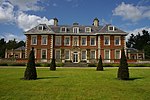Severn bore

The Severn bore is a tidal bore seen on the tidal reaches of the River Severn in south western England. It is formed when the rising tide moves into the funnel-shaped Bristol Channel and Severn Estuary and the surging water forces its way upstream in a series of waves, as far as Gloucester and beyond. The bore behaves differently in different stretches of the river; in the lower, wider parts it is more noticeable in the deep channels as a slight roller, while the water creeps across the sand and mudflats. In the narrower, upper reaches, the river occupies the whole area between its banks and the bore advances in a series of waves that move upstream. Near Gloucester, the advancing water overcomes two weirs, and sometimes one in Tewkesbury, before finally petering out. Bores are present on about 130 days in the year, concentrated on the days immediately following the new and full moon. The size and precise timing of the bore depend on such things as the time of high tide, the barometric pressure, the wind speed and direction, the amount of water coming down the river and how well scoured the main drainage channels are. There are a number of viewpoints from which the bore can be seen, or viewers can walk along the river bank or floodbanks. Historically, the bore has been of importance to shipping visiting the docks at Gloucester, but this was alleviated by the construction of an alternative route, the Gloucester and Sharpness Canal, which opened in 1827. Nowadays the bore is of interest to surfers and canoeists who attempt to ride the waves.
Excerpt from the Wikipedia article Severn bore (License: CC BY-SA 3.0, Authors, Images).Severn bore
Elmore Back,
Geographical coordinates (GPS) Address Nearby Places Show on map
Geographical coordinates (GPS)
| Latitude | Longitude |
|---|---|
| N 51.85 ° | E -2.332 ° |
Address
Elmore Back
Elmore Back
GL2 3ST , Elmore
England, United Kingdom
Open on Google Maps









